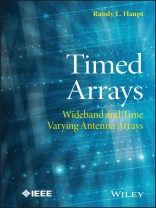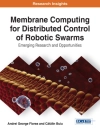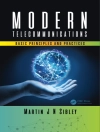Introduces timed arrays and design approaches to meet the new high performance standards
The author concentrates on any aspect of an antenna array that must be viewed from a time perspective. The first chapters briefly introduce antenna arrays and explain the difference between phased and timed arrays. Since timed arrays are designed for realistic time-varying signals and scenarios, the book also reviews wideband signals, baseband and passband RF signals, polarization and signal bandwidth. Other topics covered include time domain, mutual coupling, wideband elements, and dispersion. The author also presents a number of analog and digital beamforming networks for creating and manipulating beams. The book concludes with an overview of the methods to integrate time delay into the array design and of several other adaptive arrays that prove useful in many different systems.
- Examines RF signal concepts such as polarization and signal bandwidth and their applications to timed antenna arrays
- Covers arrays of point source, elements in timed antenna arrays, active electronically scanned array technology, and time delay in corporate fed arrays
- Includes complete design examples for placing time delay in arrays
Timed Arrays: Wideband and Time Varying Antenna Arrays is written for practicing engineers and scientists in wireless communication, radar, and remote sensing as well as graduate students and professors interested in advanced antenna topics.
Tabla de materias
List of Figures x
Preface xix
1 Timed and Phased Array Antennas 1
1.1 Large Antennas 1
1.2 Collection of Elements 3
1.3 Overview of an Array Architecture 6
1.4 Transient Versus Steady State 7
1.5 Time Versus Phase 7
1.6 Book Overview 8
References 9
2 RF Signals 10
2.1 The Carrier and Modulation 10
2.2 Noise and Interference 12
2.3 Polarization 15
2.4 Signal Bandwidth 17
Reference 18
3 Arrays of Point Sources 19
3.1 Point Sources 19
3.2 Far Field 20
3.3 Array Sampling in the Time Domain 21
3.4 Array Sampling in the Frequency Domain 22
3.5 Grating Lobes: Spatial Aliasing 23
3.6 Subarrays and Panels 26
3.7 Electronic Beam Steering 29
3.8 Amplitude Weighting 31
3.8.1 Dolph–Chebyshev Taper 32
3.8.2 Taylor Tapers 33
3.8.3 Bayliss 34
3.9 Thinned Arrays 36
References 39
4 Elements in Timed Arrays 41
4.1 Element Characteristics 41
4.1.1 Polarization 42
4.1.2 Impedance 43
4.1.3 Phase center 44
4.1.4 Conformal 44
4.1.5 Size 44
4.1.6 Directivity 45
4.1.7 Bandwidth 45
4.1.8 Balun 45
4.2 Elements 46
4.2.1 Dipole Array 46
4.2.2 Patch Array 47
4.2.3 Spiral Array 50
4.2.4 Helical Array 52
4.2.5 Tapered Slot Antenna (TSA) Array 53
4.2.6 Tightly Coupled Arrays 55
4.2.7 Fragmented Arrays 62
4.3 Mutual Coupling 63
4.4 Element Dispersion 66
4.5 Scaled Arrays 68
4.6 Interleaved Arrays 70
References 75
5 Array Beamforming 78
5.1 PCB Transmission Lines 78
5.2 S‐parameters 81
5.3 Matching Circuits 82
5.4 Corporate Feeds 82
5.5 Distributed Versus Centralized Amplification 83
5.6 Blass Matrix 84
5.7 Butler Matrix 85
5.8 Lenses 86
5.9 Reflectarrays 89
5.10 Digital Beamforming 91
References 93
6 Active Electronically Scanned Array Technology 95
6.1 Semiconductor Technology for T/R Modules 96
6.2 T/R Module Layout 98
6.3 Amplifiers 100
6.4 Switches 109
6.5 Phase Shifter 114
6.6 Attenuators 120
6.7 Limiter 121
6.8 Circulator 121
6.9 Correcting Errors through Calibration and Compensation 121
References 123
7 Time Delay in a Corporate‐Fed Array 126
7.1 Pulse Dispersion 128
7.2 Phased Array Bandwidth 130
7.3 Time Delay Steering Calculations 133
7.4 Time Delay Units 135
7.5 Unit Cell Constraints 138
7.6 Time Delay Bit Distribution at the Subarray Level 141
References 147
8 Adaptive Arrays 149
8.1 Signal Correlation Matrix 150
8.2 Optimum Array Weights 152
8.3 Adaptive Weights Without Inverting the Correlation Matrix 154
8.4 Algorithms for Nondigital Beamformers 155
8.4.1 Partial Adaptive Nulling 156
8.4.2 Adaptive Nulling with Weight Constraints 158
8.4.3 Adaptive Nulling with Cancellation Beams 159
8.5 Reconfigurable Arrays 160
8.6 Reconfigurable Elements 165
8.7 Time‐Modulated Arrays 167
8.8 Adaptive Thinning 172
8.9 Other Adaptive Array Alternatives 177
8.9.1 Beam Switching 178
8.9.2 Direction Finding 178
8.9.3 Retrodirective Array 181
8.9.4 MIMO 181
References 184
List of Symbols and Abbreviations 188
Index 194
Sobre el autor
RANDY HAUPT, Ph D, is professor and department head of EECS at the Colorado School of Mines. Prior to that, he was an RF staff consultant at Ball Aerospace & Technologies, Corp., senior scientist and department head at the Applied Research Laboratory of Penn State, professor and department head of ECE at Utah State, professor and chair of EE at the University of Nevada Reno, and professor of EE at the USAF Academy. Dr. Haupt was the Federal Engineer of the Year in 1993 and is a Fellow of the IEEE and the Applied Computational Electromagnetics Society (ACES). He received his Ph D from the University of Michigan and retired from the USAF as a Lt. Col. after starting his career as a lieutenant graduating from the USAF Academy.












